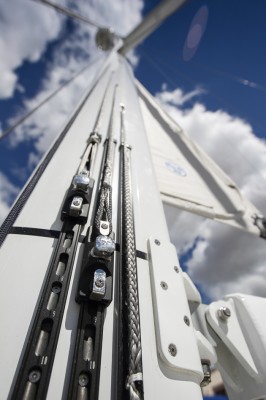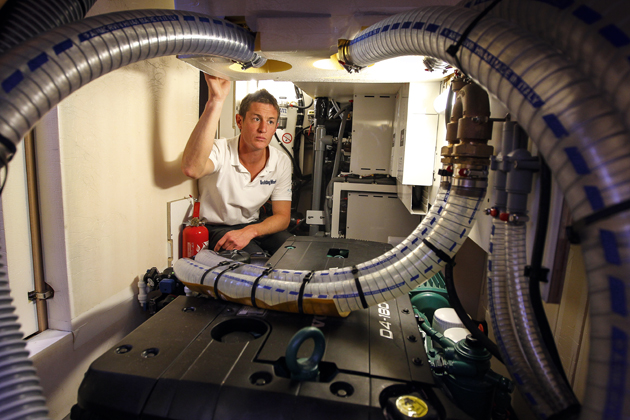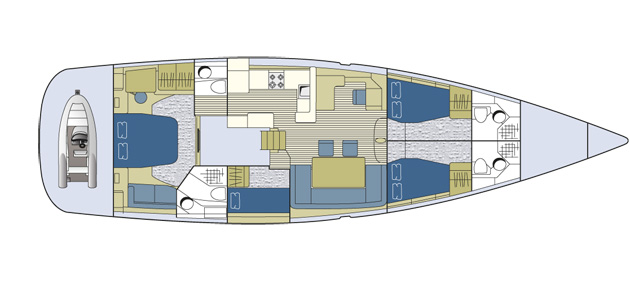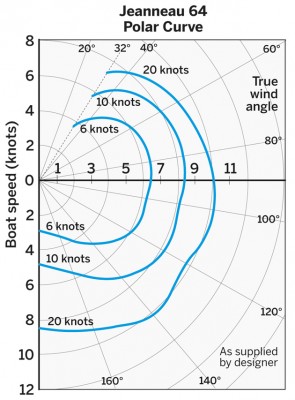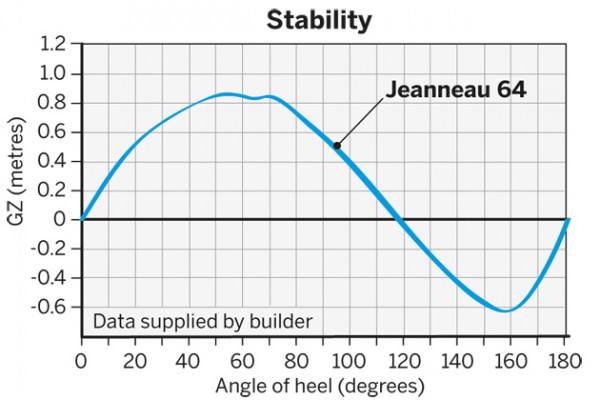So you thought you knew what a Jeanneau was – well, think again. This new flagship has aspirations to be a superyacht, but for around half the price of rival luxury brands. Toby Hodges is impressed
Jeanneau 64 boat test – a Jeanneau with superyacht ambitions
Here is a yacht guaranteed to surprise. Packed within this 64ft 1in hull, the latest from Jeanneau, are a multitude of qualities that will make you question your preconceptions about the brand. The French production builder has married the world of big-boat luxury and comfort with production boat functionality and pricing to create a new market.
The 64 has been drawn by leading superyacht designers and built by Jeanneau to an impressive quality. The pictures, specs and the base price of €858,900 (£685,583) – relatively low for a yacht of this size and type – paint an attractive picture. However, a primary concern for many will be the practicality of handling such a large vessel at sea.
Two days of sailing the 64 in gale force Mistral conditions in the south of France provided us with a ruthless test of Jeanneau’s flashy new flagship.
A small superyacht
Think Jeanneau and you probably think basic, economic no-frills production cruiser, or perhaps a wipe-clean bareboat charter yacht. Jeanneau yachts are designed and perform consistently well, but remain, essentially, middle-of-the-road cruising boats. A 64ft Jeanneau that looks like a small superyacht will take most by surprise.
This striking new Jeanneau is 8ft longer than the previous flagship, the 57, launched in 2009 – a telling indication of how LOA has spiralled in recent years.
A production run at this size requires substantial initial investment, so the yard will be depending on a certain volume of sales. Jeanneau identified that just 33 yachts between 63ft and 67ft sold worldwide last year. Yet the company is confident a new market exists in this segment, having launched 800 yachts in the 53-57ft bracket. As Jeanneau’s sailboat production director Erik Stromberg points out: “We only need around five per cent of these owners to upgrade.”
The price of the 64 will be the primary attraction. She is around half the price of other yachts of her size, which are typically luxury brands such as Oyster, Hallberg-Rassy or X-Yachts costing in the region of €2–2.5m. But does that mean there is really a market for a €1m Jeanneau? It seems so. Jeanneau has, rather astonishingly, already sold 14 of these 64s, 11 to existing owners. That is already equivalent to nearly half the global sales for this size of yacht last year.
Jeanneau still needs to ensure new levels of both style and substance to maintain this early success. The former is almost a given. By employing Philippe Briand and Andrew Winch, who have between them developed over 75 superyachts, the 64 oozes class.
A wide variety of configurations and choices have been engineered into the boat to make sure owners feel as if they are getting semi-custom treatment in a cost-effective manner. Both forward and aft owner’s cabins are available, for instance, plus workshop, Pullman and crew cabin options and hundreds of decor choices.

The helm has winches within reach, the main captive on a remote button and a tidy pedestal to control the boat from one position
However, it is the host of big boat features throughout that I thought provide the real substance behind this yacht.
Technology upgrade
Peer beneath the forward soleboards of the raised saloon and you will find a compact 1.5 tonne Harken captive winch neatly squirrelled away. The Jeanneau is the smallest production yacht to fit a captive winch, a prime example of how to use superyacht technology when price (an extra €21,500) and space allow. Here it provides push-button ease where a winch doesn’t need to share functions. A captive winch can also be fitted for the main halyard.
A vast cockpit and a walk-in engine room were the two most desirable features to top Jeanneau’s wishlist for the 64. But there are many more subtle signs of the big-boat touch throughout. For example, halyard- tensioning tracks at the mast base tidy lines that are seldom adjusted, such as furling foresail halyards. Glassfibre bulwarks that run from stem to stern look smart and provide a feeling of security on deck. And a recess is built into the anchor locker to offer the option for a rotating anchor arm.
The size of the cockpit directly led to the majority of its sales in the 53–57ft range, says Jeanneau, who established that this is where owners spend 80 per cent of their time. The brief to Philippe Briand was for a cockpit with the comfort of a motor cruiser flybridge, and the result is an enormous leisure area. This brief might, in part, also explain the motoryacht-style exterior galley additions, which comprise a fridge, sink and grill housed within optional pods.
An arch helps to give the impression of space in the cockpit by eliminating the need for sail handling or a traveller in the seating area. A huge sprayhood can link with a bimini to make this generous exterior space usable in most conditions.
Gale force test
The 64 was conceived to be the largest size of yacht that can be managed without a permanent crew. So all the styling merits and gadgets count for little if she can’t be handled easily. As the wind whistled through the rigging of yachts nestled in Marseille’s old port, I wondered whether we would be given the chance to put this to the test.
For our two-day visit, the forecast predicted 25-30 knot Mistral winds that would ease by ten knots by the second day. Nosing past the breakwater, we instantly shipped green water in the cockpit and it became clear that the winds weren’t going to listen to what the forecast suggested.
We sailed for the majority of the time with just two aboard, in winds averaging Gale Force 7-8 over both days. An in-mast furling mainsail and a self-tacking furling jib made it possible to set the optimal canvas easily, without either of us needing to leave the aft cockpit.
We reduced the mainsail until heel angle became stable – the equivalent of three reefs for the most part – and sailed with full jib where possible. The test boat had a 100 per cent furling genoa on the forestay, plus this small self-tacking jib set off an inner stay. The jib acted like a staysail, providing useful drive. It is a choice I would take in preference to the standard offering of self-tacking jib on the main forestay.
With sails set, the helmsman can control all he needs from the wheel, thanks to the mainsheet control button and primaries being within reach. The 64 proved both manageable and obedient as we reached back and forth in the calmer water in the lee of the Frioul islands. Even here the conditions were challenging, as brief lulls were followed by vicious squalls that whipped up foam from the flat water before barrelling into our tall rig. But though a big, powerful yacht weighing over 30 tonnes, the Jeanneau quickly put me at ease. She stood up well to the treatment and provided plenty of warning before she became overloaded.
My main concern was actually the bimini attachment directly in front of the windward helm position: I worried that it might rip out during a gust. It is reportedly rated to 45 knots, something we put to the test that day. Sailing with the bimini stowed proved distinctly preferable, not least for monitoring the sails.
True to form for Jeanneau yachts, the 64 provided steady, forgiving sailing rather than anything too spectacular or lively. This is a big vessel to steer. The ballast required to keep her upright is equivalent to the weight of a 43ft cruiser. Things happen slowly, but purposefully and obediently.
Jefa self-aligning bearing gear controls a single-blade, semi-balanced rudder, which proved competent in the demanding conditions – maybe a little spongy, but certainly more responsive than a similar-sized centre-cockpit system. She gave us plenty of warning before she rounded up in ladylike fashion if I took too long to identify the mainsheet button.
Currently the captive mainsheet control is mounted among other similar switches
on the starboard pedestal. This should be much more distinctive and fitted on both pedestals to allow the helmsman to dump the main quickly. Jeanneau is still working on optimum winch speeds.
We spent the majority of our time reaching in flattish water to give the photographer a sporting chance, but it was once we ventured out into the 3-4m swell that the 64 really came alive. These were conditions that could ask questions of any boat. Some boats might make you uneasy, but the Jeanneau gave us the confidence to keep heading offshore. She maintained a very steady 9.5–10 knots reaching while comfortably reefed.
It is a real pleasure to helm a boat of this size from wheels sited aft, as 64-footers tend to be centre-cockpit set-ups, from which the helmsman can feel disconnected. To stand up high at the windward wheel, staring down nearly 60ft of yacht and point the bow down into the expansive trough of a wave was exhilarating.
The comfort of the cockpit will appeal to the off-watch crew. Sit facing aft on the large sunbathing benches under the generous sprayhood and, apart from the heel angle, it’s possible to be oblivious to the conditions, even when it is howling. It’s like being in the aft cockpit of a catamaran.
Jeanneau had already sailed this prototype from Les Sables d’Olonne to Corsica. Over 2,500nm of testing time had exposed potential gremlins, which is perhaps why they were rightly confident in her ability in the conditions we experienced. It is a credit to the yard that it has ensured she is a manageable boat. A bowthruster is standard and a stern thruster is an option all owners have taken so far. It’s one that could save face and repair bills, and certainly helped us get in and out of a tight, windy berth.
24 hours aboard
Two things shone out when we stayed aboard the 64: the high-end styling, and the quality of engineering and finish. It is the smallest yacht London-based Andrew Winch has worked on in 20 years and his enthusiastic return to yacht design is marked by the intricate level of detail he has managed to incorporate in the 64. The styling is tastefully nautical and contemporary. It feels smart and special, and pulls off the grace of a superyacht.

The saloon is a tastefully styled, spacious area, with abundant natural light and views. It offers a flexible layout: the area to starboard of the companionway can be a Pullman or navstation, and that to port a sofa or a desk. The raised saloon creates room for the generator and tanks below
Winch helped select and develop the timber finish. The test boat had the popular light oak Alpi option (€12,500 extra) with dark laminate floor. This manufactured wood is the choice of most large production yards today, but this particular Alpi had been specially treated using an open-pore varnish technique to give a tactile finish.
Elsewhere leather is used to striking effect, including on door panels, and door and locker handles. The lockers all have 8mm trench surrounds, which give a neat symmetrical effect, and the solid wood edges of furniture are bevelled.
“We had to step up the quality because the psychology of people coming aboard is one that looks to why it is half the price,” explains Erik Stromberg. He admits the interiors are not fashioned by master craftsmen, but still need to look good and be easy to put together.
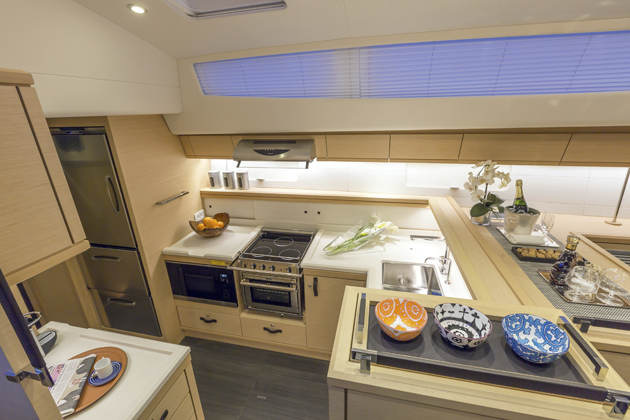
The passageway galley is secure to work in at sea, provides reasonable fiddled worksurfaces, plus plenty of dried goods stowage and options for cold stowage. It has been thoughtfully arranged to suit the idea of service, including stainless steel fridges and the siting of a cutlery drawer and drinks fridge close to the companionway. Raised locker and crockery space is limited, however
“It’s about a higher perceived value,” says Stromberg. Jeanneau uses 5-axis machines to save time where possible and the interior has been designed with a versatile layout that offers a variety of choices. In this way, Jeanneau can still build using its industrial processes, but provide enough choice for owners to feel they are getting a bespoke yacht.
The incorporation of an engine room for the first time is a big move for Jeanneau. The company has tried to house all noisy or vibrating items in this area below the cockpit. “Our client is growing up through production boats so knows the inconveniences of typical machinery systems, so more space for these is a big selling point,” says Stromberg. Three access points make servicing practical. Space is a little tight in comparison with engine rooms aboard centre-cockpit yachts, though.
Despite the efforts to contain noise, the generator is housed outside the engine room, below the saloon floor, so is noticeable when running. But we still ran a quiet ship for the night, thanks to 860ah of 24V batteries, even while charging laptops and camera gear and running the dishwasher. The Jeanneau can run silently for 24 hours offshore on batteries alone, unless aircon is required.
A touchscreen panel mounted beside the companionway provides an intuitive means of monitoring and controlling most of the systems on board. It was developed in-house to monitor tanks, batteries, lights and generator operation. It allows for easy interrogation of the system, down to keeping track of each individual battery’s charge and temperature.
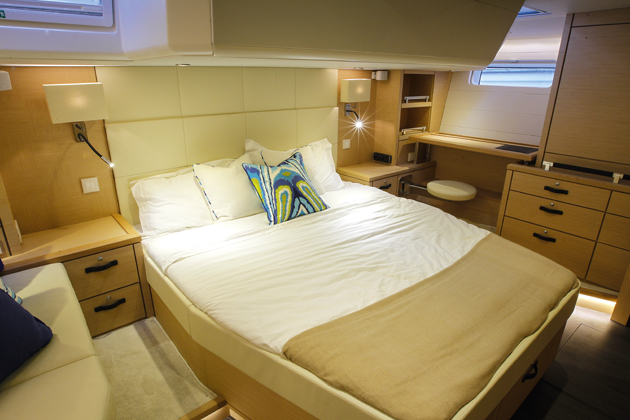
Owner’s cabin (aft): a smart ensuite cabin, albeit not quite up to Oyster or Gunfleet standards of space and luxury. Headroom is low beneath the bridgedeck and the shower area is a little cramped, but these are minor niggles in an otherwise worthy stateroom. The twin curved, aft-facing escape hatches contribute to the natural light, and stowage is neat and practical
After two days aboard, my list of interior faults is short. The doorways are unnecessarily narrow; the sinks are laughably small; the bulkhead between guest cabins is flimsily thin so doesn’t provide adequate noise insulation; the soleboards would benefit from spacers to prevent creaking; raised lockers are all too small; bedside shelves would be a benefit; and the towel rails are inadequate. For the first boat off the line, however, that equates to impressively few complaints.
Specifications
LOA 20.10m/65ft 11in
LWL 18.00m/59ft 1in
Beam (max) 5.40m/17ft 9in
Draught 2.95m 9ft 8in
Disp (lightship) 31,000kg/68,343lb
Ballast 9,350kg/20,613lb
Sail area (100% foretriangle) 204.1m2/2,197ft2
Berths 6-10
Engine 180hp Volvo shaftdrive
Water 1,000lt/220gal
Fuel 825lt/181gal
Sail area:disp 21.0
Disp:LWL 148
Price ex VAT €858,900 – Test boat: €1,194,050
Designed by Philippe Briand Yacht Design/Andrew Winch Designs
www.jeanneau.com
Conclusion
The Jeanneau 64 is certainly a boat full of surprises, and one that should be lauded for her styling and engineering. With their current Sun Odyssey range, Jeanneau and Briand have proved, model after model, that they provide the complete boat in terms of layout, performance and handling. So perhaps it should have come as no surprise that the 64 maintains those fundamental qualities.
But how much will her brand name affect buyers’ choice? Would you favour a 26in B&O flatscreen TV over a 40in LG, for example? However accomplished her design and however well she performs, she remains, for better or worse, a Jeanneau. Rather than try to camouflage this fact by using different branding, Groupe Beneteau has embraced it, knowing that the quality needs to be over and above any preconceived perceptions. The Jeanneau you thought you knew has consequently changed.
Like the choice in TVs, the Jeanneau offers 10ft more yacht than an equivalent-priced semi-custom yacht. But it’s not simply about more boat for the buck.
To want to spend seven figures on a Jeanneau, it must make you feel as if you’ve spent a million, yet still got a bargain.
And I think it does.
This is an extract from a feature in Yachting World October 2014 issue







